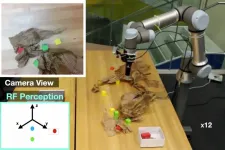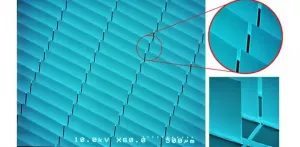(Press-News.org) LA JOLLA--(April 1, 2021) Neurons lack the ability to replicate their DNA, so they're constantly working to repair damage to their genome. Now, a new study by Salk scientists finds that these repairs are not random, but instead focus on protecting certain genetic "hot spots" that appear to play a critical role in neural identity and function.
The findings, published in the April 2, 2021, issue of Science, give novel insights into the genetic structures involved in aging and neurodegeneration, and could point to the development of potential new therapies for diseases such Alzheimer's, Parkinson's and other age-related dementia disorders.
"This research shows for the first time that there are sections of genome that neurons prioritize when it comes to repair," says Professor and Salk President Rusty Gage, the paper's co-corresponding author. "We're excited about the potential of these findings to change the way we view many age-related diseases of the nervous system and potentially explore DNA repair as a therapeutic approach."
Unlike other cells, neurons generally don't replace themselves over time, making them among the longest-living cells in the human body. Their longevity makes it even more important that they repair lesions in their DNA as they age, in order to maintain their function over the decades of a human life span. As they get older, neurons' ability to make these genetic repairs declines, which could explain why people develop age-related neurodegenerative diseases like Alzheimer's and Parkinson's.
To investigate how neurons maintain genome health, the study authors developed a new technique they term Repair-seq. The team produced neurons from stem cells and fed them synthetic nucleosides--molecules that serve as building blocks for DNA. These artificial nucleosides could be found via DNA sequencing and imaged, showing where the neurons used them to make repairs to DNA that was damaged by normal cellular processes. While the scientists expected to see some prioritization, they were surprised by just how focused the neurons were on protecting certain sections of the genome.
"What we saw was incredibly sharp, well-defined regions of repair; very focused areas that were substantially higher than background levels," says co-first and co-corresponding author Dylan Reid, a former Salk postdoctoral scholar and now a fellow at Vertex Pharmaceutics. "The proteins that sit on these 'hot spots' are implicated in neurodegenerative disease, and the sites are also linked to aging."
The authors found approximately 65,000 hot spots that covered around 2 percent of the neuronal genome. They then used proteomics approaches to detect what proteins were found at these hot spots, implicating many splicing-related proteins. (These are involved in the eventual production of other proteins.) Many of these sites appeared to be quite stable when the cells were treated with DNA-damaging agents, and the most stable DNA repair hot spots were found to be strongly associated with sites where chemical tags attach ("methylation") that are best at predicting neuronal age.
Previous research has focused on identifying the sections of DNA that suffer genetic damage, but this is the first time researchers have looked for where the genome is being heavily repaired.
"We flipped the paradigm from looking for damage to looking for repair, and that's why we were able to find these hot spots," Reid says. "This is really new biology that might eventually change how we understand neurons in the nervous system, and the more we understand that, the more we can look to develop therapies addressing age-related diseases."
Gage, who holds the Vi and John Adler Chair for Research on Age-Related Neurodegenerative Disease, adds, "Understanding which areas within the genome are vulnerable to damage is a very exciting topic for our lab. We think Repair-seq will be a powerful tool for research, and we continue to explore additional new methods to study genome integrity, particularly in relation to aging and disease."
INFORMATION:
Other authors on the study are Patrick Reed, Ioana Nitulescu, Enoch Tsui, Jeffrey Jones, Claire McClain, Simon Schafer, Grace Chou, Tzu-Wen Wang, Nasun Hah, Sahaana Chandran and Jesse Dixon of Salk; Johannes Schlachetzki, Addison Lana, and Christopher Glass of the University of California, San Diego; Ake Lu and Steve Horvath of the University of California, Los Angeles.
The research was supported by the American Heart Association, the Paul G. Allen Frontiers Group, the JPB Foundation, the Dolby Foundation, the Helmsley Charitable Trust, and the National Institutes of Health.
About the Salk Institute for Biological Studies:
Every cure has a starting point. The Salk Institute embodies Jonas Salk's mission to dare to make dreams into reality. Its internationally renowned and award-winning scientists explore the very foundations of life, seeking new understandings in neuroscience, genetics, immunology, plant biology and more. The Institute is an independent nonprofit organization and architectural landmark: small by choice, intimate by nature and fearless in the face of any challenge. Be it cancer or Alzheimer's, aging or diabetes, Salk is where cures begin. Learn more at: salk.edu.
On the afternoon of April 13, 2018, a large wave of water surged across Lake Michigan and flooded the shores of the picturesque beach town of Ludington, Michigan, damaging homes and boat docks, and flooding intake pipes. Thanks to a local citizen's photos and other data, NOAA scientists reconstructed the event in models and determined this was the first ever documented meteotsunami in the Great Lakes caused by an atmospheric inertia-gravity wave.
An atmospheric inertia-gravity wave is a wave of air that can run from 6 to 60 miles long that is created when a mass of stable air is displaced by an air mass with significantly ...
In recent years, robots have gained artificial vision, touch, and even smell. "Researchers have been giving robots human-like perception," says MIT Associate Professor Fadel Adib. In a new paper, Adib's team is pushing the technology a step further. "We're trying to give robots superhuman perception," he says.
The researchers have developed a robot that uses radio waves, which can pass through walls, to sense occluded objects. The robot, called RF-Grasp, combines this powerful sensing with more traditional computer vision to locate and grasp items that might otherwise be blocked from view. The advance could one day streamline e-commerce fulfillment in warehouses or help a machine pluck a screwdriver from a jumbled toolkit.
The research will be presented in May at the IEEE International ...
Plant inducible defense starts with the recognition of microbes, which leads to the activation of a complex set of cellular responses. There are many ways to recognize a microbe, and recognition of microbial features by pattern recognition receptors (PRRs) outside the cell was long thought to activate the first line of defense: Pattern Triggered Immunity, or PTI. To avoid these defense responses, microbes of all kinds evolved the ability to deliver effector molecules to the plant cell, either directly into the cytoplasm or into the area just outside the cell, where they are taken up into the cytoplasm. ...
New research published today in the journal Blood Advances is the first to show that restricting calories, reducing fat and sugar intake, and increasing physical activity may boost the effectiveness of chemotherapy for older children and adolescents with leukemia. This intervention, which improved chemotherapy outcomes for children being treated at two institutions, will be further studied through a national trial later this year.
B-cell acute lymphoblastic leukemia (B-ALL), a cancer affecting the white blood cells in the bone marrow, is the most common type of cancer in children. In the study, researchers assessed the effects of diet and exercise on 40 individuals aged 10-21 undergoing chemotherapy at ...
In some cancers, including leukemia in children and adolescents, obesity can negatively affect survival outcomes. Obese young people with leukemia are 50% more likely to relapse after treatment than their lean counterparts.
Now, a study led by researchers at UCLA and Children's Hospital Los Angeles has shown that a combination of modest dietary changes and exercise can dramatically improve survival outcomes for those with acute lymphoblastic leukemia, the most common childhood cancer.
The researchers found that patients who reduced their calorie intake by 10% or more and adopted a moderate exercise program immediately after their diagnosis had, on average, 70% less ...
For years, research to pin down the underlying cause of Alzheimer's Disease has been focused on plaque found to be building up in the brain in AD patients. But treatments targeted at breaking down that buildup have been ineffective in restoring cognitive function, suggesting that the buildup may be a side effect of AD and not the cause itself.
A new study led by a team of Brigham Young University researchers finds novel cellular-level support for an alternate theory that is growing in strength: Alzheimer's could actually be a result of metabolic dysfunction in the brain. In other words, there is growing evidence that diet and lifestyle are at the ...
Los Angeles (April 1, 2021) -- Overweight children and adolescents receiving chemotherapy for treatment of leukemia are less successful battling the disease compared to their lean peers. Now, research conducted at the END ...
Buildings are responsible for 40 percent of primary energy consumption and 36 percent of total CO2 emissions. And, as we know, CO2 emissions trigger global warming, sea level rise, and profound changes in ocean ecosystems. Substituting the inefficient glazing areas of buildings with energy efficient smart glazing windows has great potential to decrease energy consumption for lighting and temperature control.
Harmut Hillmer et al. of the University of Kassel in Germany demonstrate that potential in "MOEMS micromirror arrays in smart windows for daylight steering," a paper published recently in the inaugural issue of the Journal of Optical Microsystems.
"Our smart glazing ...
A highly contagious SARS-CoV-2 variant was unknowingly spreading for months in the United States by October 2020, according to a new study from researchers with The University of Texas at Austin COVID-19 Modeling Consortium. Scientists first discovered it in early December in the United Kingdom, where the highly contagious and more lethal variant is thought to have originated. The journal Emerging Infectious Diseases, which has published an early-release version of the study, provides evidence that the coronavirus variant B117 (501Y) had spread across the globe undetected for months when scientists discovered it.
"By the time we learned about the U.K. variant ...
A possible explanation for why many cancer drugs that kill tumor cells in mouse models won't work in human trials has been found by researchers with The University of Texas Health Science Center at Houston (UTHealth) School of Biomedical Informatics and McGovern Medical School.
The research was published today in Nature Communications.
In the study, investigators reported the extensive presence of mouse viruses in patient-derived xenografts (PDX). PDX models are developed by implanting human tumor tissues in immune-deficient mice, and are commonly ...





